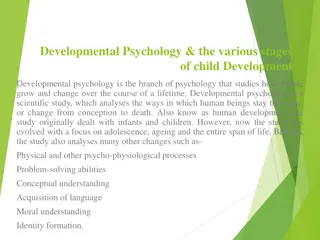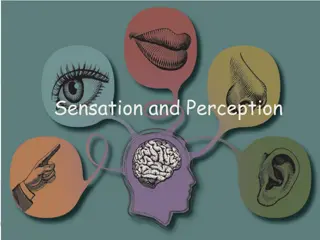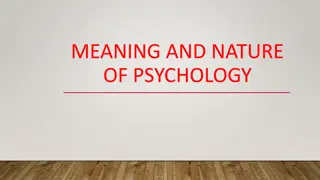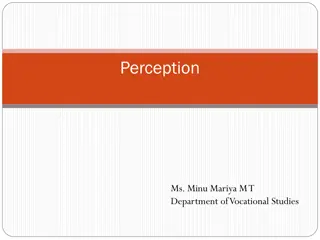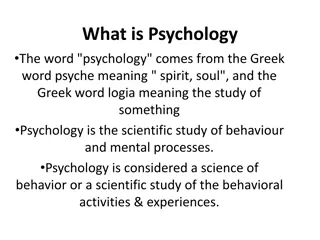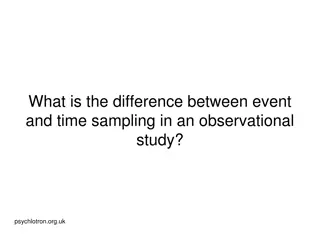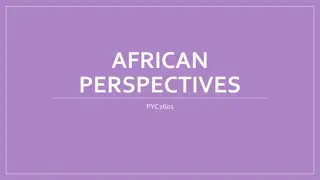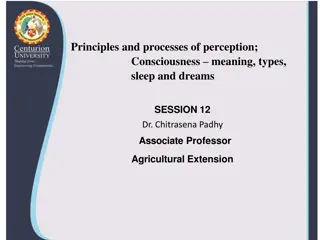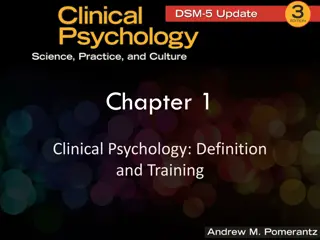Understanding Sensation and Perception in Psychology
Explore the fascinating world of sensation and perception in psychology, where we delve into how our senses interact with stimuli to create our conscious experiences. Sensation involves the activation of our sense organs by external stimuli, while perception refers to the interpretation of those stimuli by the brain. Through transduction, sensory information is transformed into neural signals for processing in the brain. Psychophysics elucidates the intricate relationship between sensory experiences and the physical stimuli that evoke them. Ultimately, our sensory experiences are processed and interpreted in the brain, highlighting the complex mechanisms behind vision, hearing, and the other senses. Learn about thresholds, including the absolute threshold, which is the minimum stimulus level required for detection.
Download Presentation

Please find below an Image/Link to download the presentation.
The content on the website is provided AS IS for your information and personal use only. It may not be sold, licensed, or shared on other websites without obtaining consent from the author. Download presentation by click this link. If you encounter any issues during the download, it is possible that the publisher has removed the file from their server.
E N D
Presentation Transcript
Sensation: your window to the world Perception: interpreting what comes in your window.
What is Sensation? A stimulus sensory or behavioral response in an organism. is any object or event that elicits a A Sensation occurs anytime a one of your receptors. The sense organs then detect any change in energy, such as light, heat, sound, and physical pressure. stimulus activates
What is Sensation? Sensation occurs when special receptors in the sense organs the eyes, ears, nose, skin, and taste buds are activated, allowing various forms of outside stimuli to become neural signals in the brain. (This process of converting outside stimuli, such as light, into neural activity is called transduction.)
Sensory systems Transduction - Communication between the brain & the rest of the body occurs via neuron. Information goes from the senses to the thalamus , then to the various areas in the brain. All senses involve something called receptor cells. Their job is to transduce (transform or even translate ) physical stimulation/physical energy from the environment into electrochemical messages that can be understood by the brain.
Psychophysics This explains how sensation and perception are related Psychophysics: The study of the relationships between sensory experiences and the physical stimuli that cause them!
So where do vision and hearing (& the other senses) happen? The Brain! The physical energy in the environment is detected by the eyes, ears, etc. but we can t see, hear, etc. until the brain interprets them i.e., makes sense of them. So in a way, we see, hear, smell, etc. in our brains!
Absolute Threshold The Absolute Threshold is the level of stimulus that produces a positive response of detection 50% of the time. the lowest level of stimulation that a person can consciously detect 50 percent of the time the stimulation is present.
Webers law of just noticeable differences (jnd, or the difference threshold). The difference threshold is the amount of change needed for us to recognize that a change has occurred. It s the smallest difference between two stimuli that is detectable 50 percent of the time Weber's Law states that The larger or stronger the stimulus, the larger the change required for a person to notice that anything has happened to it.
Example Imagine holding a five pound weight and one pound was added. Most of us would notice this difference. But what if we were holding a fifty pound weight? Would we notice if another pound were added? The reason many of us would not is because the change required to detect a difference has to represent a percentage. In the first scenario, one pound would increase the weight by 20%, in the second, that same weight would add only an additional 2%.
Sensory Adaptation Adaptation (sometimes called habituation) is a part of everyday experience. It s a decreased responsiveness to stimuli due to constant stimulation. We are able to respond to the changes in our environment because our senses have the ability to adapt, or adjust themselves, to a constant level of stimulation. Once your senses get used to a new level of a stimulation, they respond only to deviations from it.
Signal detection theory (SDT) was originally developed to describe the performance of radars, which must detect signals against a background of noise. As radars become more sensitive (capable of detecting weaker and weaker signals), they are increasingly able to correctly detect when signals are present; these events are called hits, and their probability of occurrence is the hit rate. However, radars may also mistake noise for signals; these events are false alarms, and the corresponding probability is the false alarm rate.




